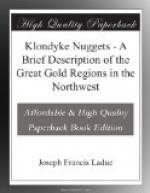“In 1848 Campbell established Fort Selkirk at the confluence of the Pelly and Lewes Rivers; it was plundered and destroyed in 1852 by the Coast Indians, and only the ruins now exist of what was at one time the most important post of the Hudson’s Bay Company to the west of the Rocky Mountains in the far north. In 1869 the Hudson’s Bay Company’s officer was expelled from Fort Yukon by the United States Government, they haying ascertained by astronomical observations that the post was not located in British territory. The officer thereupon ascended the Porcupine to a point which was supposed to be within British jurisdiction, where he established Rampart House; but in 1890 Mr. J.H. Turner of the United States Coast Survey found it to be 20 miles within the lines of the United States. Consequently in 1891 the post was moved 20 miles further up the river to be within British territory.
“The next people to enter the country for trading purposes were Messrs. Harper and McQuestion. They have been trading in the country since 1873 and have occupied numerous posts all along the river, the greater number of which have been abandoned. Mr. Harper is now located as a trader at Fort Selkirk, with Mr. Joseph Ladue under the firm name of Harper & Ladue, and Mr. McQuestion is in the employ of the Alaska Commercial Company at Circle City, which is the distributing point for the vast regions surrounding Birch Creek, Alaska. In 1882 a number of miners entered the Yukon country by the Taiya Pass; it is still the only route used to any extent by the miners, and is shorter than the other passes though not the lowest. In 1883 Lieutenant Schwatka crossed this same pass and descended the Lewes and Yukon Rivers to the ocean.
“The explorers found that in proximity to the boundary line there existed extensive and valuable placer gold mines, in which even then as many as three hundred miners were at work. Mr. Ogilvie determined, by a series of lunar observations, the point at which the Yukon River is intersected by the 141st meridian, and marked the same on the ground. He also determined and marked the point at which the western affluent of the Yukon, known as Forty Mile Creek, is crossed by the same meridian line, that point being situated at a distance of about twenty-three miles from the mouth of the creek. This survey proved that the place which had been selected as the most convenient, owing to the physical conformation of the region, from which to distribute the supplies imported for the various mining camps, and from which to conduct the other business incident to the mining operations—a place situate at the confluence of the Forty Mile Creek and the Yukon, and to which the name of Fort Cudahy has been given—is well within Canadian territory. The greater proportion of the mines then being worked Mr. Ogilvie found to be on the Canadian side of the international boundary line, but he reported the existence of some mining fields to the south, the exact position of which with respect to the boundary he did not have the opportunity to fix.




